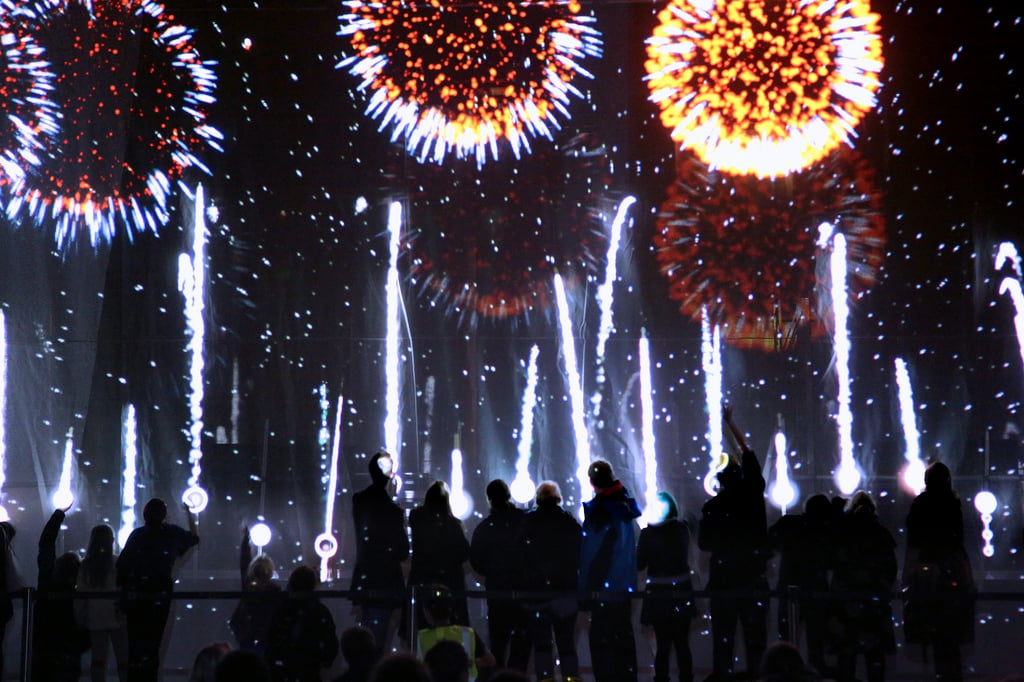
Participants at a PixelPyros performance
Photo: Joe Hague
Created in code
Seb Lee-Delisle describes how he used computer programming to create an interactive fireworks display.
Late last year my PixelPyros project went on a tour of five nationwide dates. It is an outdoor digital fireworks display that uses massive projectors and lasers to project computer-generated firework effects on to a four-storey-high screen. But it is anything but a passive display − the rockets are fired by audience members who wave their hands in front of the light triggers that run along the bottom of the screen.
There is something really wonderful about creating a ‘happening' − an event that gets attention and draws big crowds. It reminds me of my time several years ago as part of a samba drumming band − we would just have to show up and suddenly everyone wanted to see what was happening. PixelPyros is the same – it is just all done with computers − and what is even better about it is its ability to draw young people in. Like it or not, and despite what digital culture's harshest critics might say, for many young people it is what interests them, connects them socially, and can inspire them creatively.
As an artist, current technology inspires and excites me
For me that creativity involves making graphics and animations with computers. I don’t mean Photoshop and AfterEffects. I write the code to create the graphics I need. The project uses particle systems and simple physics simulations to make all the effects. It’s all real-time, nothing is pre-rendered.
It has been the same ever since I was a kid. My dad brought an old BBC micro computer home and I immediately wanted to draw and animate pictures. With the early computers there was no software to help so I had no choice but to learn to program. Working with graphics was fun and in my view the best way to learn to program. I was lucky to be a child in the 1980s as it was much harder to learn to program throughout the 1990s and 2000s. The prevailing operating system was Windows and you needed expensive tools to program. ICT in schools concentrated on using applications more than making them.
Thankfully, today's school curriculum is being updated to include software engineering, and I am excited to see projects like the Raspberry Pi and Code Club which actively encourage children and young people to learn to program computers. Anyone wanting to learn to program now has instant access to several platforms and languages, along with lots of tutorials and documentation on the internet.
Code Club is a nationwide network of free, volunteer-led, after-school coding clubs for children aged 9 to 11. It is a non-profit organisation and in only two years has grown to nearly 2,000 clubs worldwide. The Raspberry Pi is a cheap computer on a single circuit, inspired by the BBC micro. They start at around £20 and give children ownership of their own computer, which is an important part of feeling empowered to explore and learn to code.
There is also a thriving community of makers and hackspaces, which seems to be a direct result of our TVs, phones and other gadgets becoming more closed off and inaccessible. This community is an important part of my work and I am lucky to have access to BuildBrighton, the local hackspace, a non-profit member-run organisation, that gives me access to lathes, laser cutters, welders and electronics experts. With computers becoming more powerful, and programming languages getting more accessible, it has never been a better time to work in technology. As an artist, current technology inspires and excites me and it is changing all the time. I’m barely getting started.
Seb Lee-Delisle is a digital artist who created PixelPyros.
pixelpyros.org
seb.ly
If you are interested in learning to code check out Dan Shiffman’s excellent Hour of Code.
Join the Discussion
You must be logged in to post a comment.